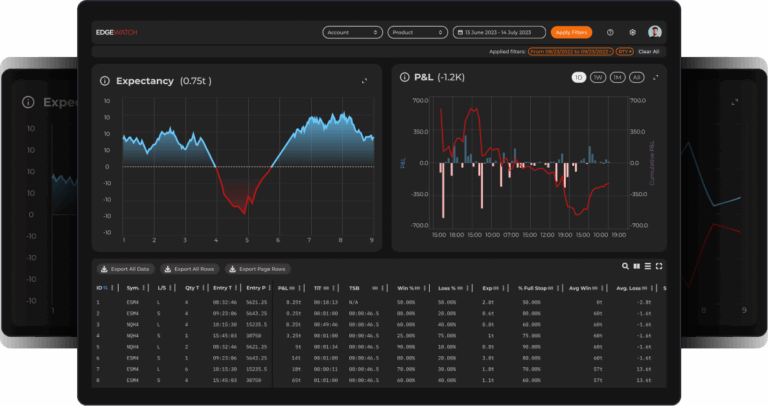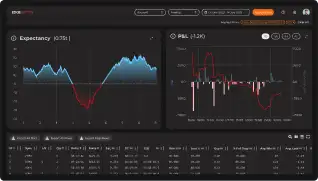
March 18,2025 @05:00 AM
We all dream of being there. Successfully trading; independently or with prop. When dreams become a reality, there’s usually a good story about how it happened.
Perhaps it’s luck, some might say it’s fate, or maybe it’s a decade-long endurance test of the mind, body and soul.
As Futurestrader71 says about trading, “It is simple, but not easy.”
Great Expectations!
On a hot summer day, the sun blazes over a pristine shoreline, waves crashing with a rhythm. “Harmonic Waves!” The trader muses. He closes his eyes and listens to the sound of waves replacing the hum of watching screens 10 hours a day. He draws a deep breath, taking in this feeling of success.
Replaying each time he followed his process and executed his trade plan during the past six months, whether the outcome of trades were wins or losses. Staying disciplined and believing in his edge, and himself, is what got him here.
This is his first vacation after being a trader for 4 years; he is finally set on having a good first year. His trading coach advised him to take a break and remember the last six months. The skills that he worked so hard to develop were starting to pay off. He smiles as he thinks about advanced algorithms, big hedge funds, investment bankers, and those with decades of experience in the markets, and yet he is able to experience some success. He ingrains what it took. It was survival at first, getting to a point where he was consistent, then focusing on growth and profitability.
He knows that despite being profitable overall, he will experience losses. Losses, he understands, are an inherent part of the game; nothing personal, not his self-worth and not his enemy. He has learnt that his biggest enemy is his ego. Losses are never failures, only lessons in disguise.
Unlike many, now he has no boss breathing down his neck, no corporate ladder to climb.
He knows that when summer ends, he will return to the screens with the same relentless discipline, feeling refreshed, sharpened, and ready to put in the work required, once more.
What you read above is an example of the expectations you may have about living the lifestyle of a consistently profitable and successful trader.
Expectancy and Reality?
Now, let’s visit what your expectancy might look like! What stands in its way; what can you do to overcome losses, blowing up accounts, and failing over and over?
Expectancy = (Avg Win * Win %) – (Avg Loss * Loss%)
Expectancy can be tracked either in $ value or ticks.
Depending on which markets you trade, and how many, it may be best to track your progress in each market separately and have a combined journal to know your overall expectancy.
As a trader, understanding the equation above can provide insights into your trading journey:
- Risk / Reward Ratio
- Avg Win / Avg Loss Ratio
- Expectancy
- Percentage of Winners
- Percentage of Losers
What stands in the way of you achieving positive expectancy are your trading errors. Many traders also refer to these as “trading demons”.
Overcome your trading errors before they destroy your trading account. As the saying goes, “what gets measured gets done”. If you are journaling your trades and have a process in place to record all of your trades, you will become aware of your trading mistakes.
Here, we will talk about the most common trading errors that haunt many traders and block their path to achieving consistency.
- Not taking a planned trade
- Taking an unplanned trade
- Poor risk reward trade
- Poor position sizing
- Poor trade management
- Poor execution
Let’s be honest, many traders only think of success but not the work required to get there. Their focus is on money, not the process. They don’t accept losses; they don’t accept probabilistic approaches. They don’t accept the random nature of markets.
Many new traders make trading too personal. When we say personal, we mean that they think the markets are out to “get them”, hunt their stop loss, take out their position and then go to their defined target. In Futures Trading 201, we define our approach and the way we look at markets. The market is simply a two-way auction with a job to facilitate buyers and sellers. New traders dig themselves a hole, then to get out of this hole they over-leverage, and fail to track their performance because they don’t want to accept their failure. They stop planning their trades, they become impatient, impulse takes over and the chimp starts acting out. Chimp Paradox is a great book to read on how to better manage your chimp brain, gremlins that clog your path to consistency, and how to rewire your habits and environment to focus on the process instead of the outcomes.
Accepting randomness in markets means also accepting that the outcomes of your trades are random. It is a long series of trades that provides insight into your expectancy and your last trade, whether it is a win or loss is irrelevant. Professional trading is not a get rich quick scheme.
Track your errors, set yourself rules and a repeatable process.
- After how many times committing the same error do you stop or pause trading?
- What do you do to ensure you are respecting and honoring your risk limits?
- How do you ensure you remain patient and only execute trades that are part of your plan?
- How do you overcome fear of not pulling the trigger when the trade setup that you practiced over and over shows up?
The trade setup may be a part of your edge, but perhaps you don’t believe in it and have not practiced it enough to execute in real time. When practicing on a simulator it is important to note that these are not real market conditions, past performance is not indicative of future results. Hypothetical performance has inherent limitations. Account for this and penalize your expectancy achieved in simulated backtests.
Discipline is key, following a process as we talk about it in our “Reading the Pitch” blog post about improving trade discipline.
Having a process in place and tracking your performance is crucial to your survival. Constantly evolve and hone your edge so that you continue doing what works, and eliminate what doesn’t.
And most important of all, hunt down your trading errors and demons.
Tracking your trading errors will provide an insight into what your expectancy looks like; with errors and without errors. If you are honest with yourself, and have an accountability partner or a trading coach to help you stay grounded in reality, you will accept these errors as part of your trading journey and then work to eliminate them, or reduce their impact to your expectancy. After all, we are still humans. Even an automated system can suffer a streak of losses.
A good trader with discipline will have a trading process defined, which not only includes:
- Market analysis
- Trade plan
- Trade setup
- Risk management plan
- Execution
- Trade management
But also focuses on:
- Journaling trades
- Tracking errors
- Reviewing trades daily and weekly
- Gathering statistics to hone and improve your trading edge.
Harness Actionable Insights with EdgeWatch
We believe that to truly harness expectancy in your trading, you need consistent feedback and clear performance data. That’s why we developed EdgeWatch, EdgeClear’s powerful trading analysis platform. Built specifically for futures traders, EdgeWatch makes it easy to track your trades, spot recurring errors, analyze your edge, and measure progress over time.
With intuitive dashboards and deep analytics, it empowers traders to refine their approach, stay accountable, and continuously optimize performance—key ingredients in turning expectancy from theory into real-world results.

It is also important to put into perspective that your inner voice will do its best to undo you. So, a trading coach or an accountability partner can provide insights into your trading that you may think are not errors, but indeed are. You do not have to trade alone. If you were to go that route, the weight of losses and sleepless nights will wreak havoc on your trading performance.
Trading, as we mentioned, is one of the hardest games. Just like athletes require training, game plan, healthy diet, good sleep, and a process in place to become elite athletes, trading requires a good process, the right environment, and positive habits in place to translate losses into consistency and make a push towards profitability.
Climbing the Mountain to Consistency
How determined are you to be a consistently profitable trader? Our above-mentioned succinct synopsis starts at the base of the mountain. If you think of trading as climbing a peak, you will realize that you will have to navigate both smooth and rough terrain, face storms, camp at different elevations, and experience setbacks that will require you to recalculate your route.
It is your responsibility to carefully steer clear of storms, landslides and slippery slopes that will push you back to the bottom. Across the top, you will come to a better place, that pristine shoreline and harmony of crashing waves awaits!
Disclaimer: Trading Derivatives involves a substantial risk of loss and is not suitable for all investors. The information contained in this post is for informational purposes only and not financial advice.
